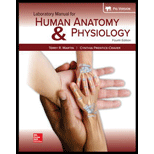
Pre-Lab Questions Select the correct answer for each of the following questions:
Muscles of mastication are all inserted on the
a. mandible.
b. maxilla
c. tongue.
d. teeth.
Introduction :
The oval cavity present in the skull is called the mouth. The mouth consists of various parts like lips, jaws, teeth, and vestibule. The teeth are located in the socket present in the jaw. The teeth are involved in splitting food into smaller parts. The zone between the lips, cheeks, and teeth is called the vestibule.
Answer to Problem 1PL
Correct answer :
The correct answer is option (a) mandible.
Explanation of Solution
Explanation/justification for the correct answer :
Option (a) mandible. The mastication muscles originated from the skull that ends in the mandibles. The mandible is present in the lower jaw. At the time of contraction, jaw movements are allowed by these mastication muscles. The muscles involved in the mastication are inserted in the mandible. So, the correct answer is an option (a).
Explanation for incorrect answer :
Option (b) maxilla. The maxilla is the fixed bone that is present in the upper jaw. The two maxillary bones fused together to form the fixed maxilla. The front of the mouth consists of the hard palate in the upper jaw. So, this is an incorrect option.
Option (c) tongue. The muscular organ of the mouth called tongue involves in the process of mastication and swallowing. It plays an important role in the digestive system and contains gustatory receptors. So, this is an incorrect answer.
Option (d) teeth. The layers pulp, dentin, cementum, and enamel together form the teeth. Teeth are not muscular in nature. The teeth do not contain muscles for mastication. So, this is an incorrect answer.
Want to see more full solutions like this?
Chapter 22 Solutions
Laboratory Manual For Human Anatomy & Physiology
Additional Science Textbook Solutions
Physics for Scientists and Engineers
College Physics: A Strategic Approach (3rd Edition)
Laboratory Manual For Human Anatomy & Physiology
SEELEY'S ANATOMY+PHYSIOLOGY
Biology: Life on Earth with Physiology (11th Edition)
Cosmic Perspective Fundamentals
- This entire structure using lifecycle terminology is called what? megastrobilus microstrobilus megasporophyll microsporophyll microsporangium megasporangium none of thesearrow_forwardHow much protein should Sarah add to her diet if she gets pregnant? Sarah's protein requirements during pregnancy would be higher. See Hint B2. During calculations, use numbers rounded to the first decimal place. In your answer, round the number of grams to the nearest whole number. _______ g ?arrow_forwardC MasteringHealth MasteringNu X session.healthandnutrition-mastering.pearson.com/myct/itemView?assignment ProblemID=17396422&attemptNo=1&offset=prevarrow_forwardMost people, even those who exercise regularly at low to average intensity (1 hour at the gym or a 2- to 3-mile walk several times per week), do not need an increased protein intake. What would be the protein needs of a man named Josh who exercises moderately and is the same age and size as Wayne? Josh is 5 ft, 8 in tall and weighs 183 lb. Round the number of grams to the nearest whole number. During calculations, use numbers rounded to the first decimal place. Because protein requirement is a range, please enter two numbers: lower and upper range values, respectively. Separate the lower and upper range values, in that order, by a comma. ___, ___ g ?arrow_forwardC MasteringHealth MasteringNu X session.healthandnutrition-mastering.pearson.com/myct/itemView?assignment ProblemID=17396422&attemptNo=1&offset=prevarrow_forwardIf left untreated, most HIV-infected individuals will develop AIDS. Current treatments are focused on highlyactive antiretroviral therapy (HAART). HAART usually consists of an orally delivered drug cocktail containingtwo different reverse transcriptase inhibitors and one other drug, such as a protease inhibitor. Question: Develop a pharmacokinetic model of HAART treatment. Consider all 3 drugs. Make sure to include adiagram that illustrates your thinking, state all assumptions, and define your variables. Whatparameters would you need to know to find the concentration of drug in the plasma? In the T cells?(You do not need to write out or solve any equations.)arrow_forwardnot use ai pleseaarrow_forward(A) 25 20 20 15 NPP (Mg C/ha/yr) 10 10 5 0 0 2,000 4,000 6,000 ECOLOGY 4e, Figure 20.11 (Part 1) 2017 Sinauer Associates, Inc. Average annual precipitation (mm) 8,000arrow_forwardexplain the cascade of events (starting with relaxing trade winds) that occurs during El Niño in the eastern Pacific (off the coasts of California/North America and Peru/South America) and which lead to food-chain collapse - start with changes in the physical/oceanographic conditions, andthen systematically describe the cascading effects at each level of the food chain -arrow_forward3) Which statement(s) about the Pacific Decadal Oscillation (PDO) is/are TRUE? CIRCLE ALL THAT APPLY. A. It is a major driver of salmon populations in the Pacific B. It affects sea surface temperatures in the eastern Pacific C. Its cycles typically do not last as long as those of ENSO D. Evidence that it has occurred over many centuries has been gathered from tree ring dataarrow_forward4.arrow_forward2arrow_forwardarrow_back_iosSEE MORE QUESTIONSarrow_forward_iosRecommended textbooks for you
- Basic Clinical Lab Competencies for Respiratory C...NursingISBN:9781285244662Author:WhitePublisher:Cengage
Basic Clinical Lab Competencies for Respiratory C...NursingISBN:9781285244662Author:WhitePublisher:Cengage
